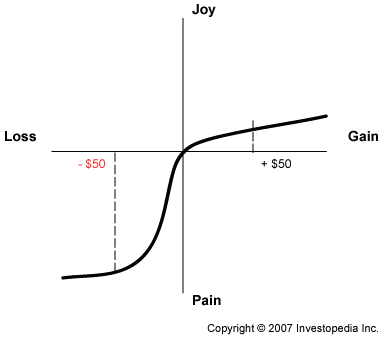Economists Daniel Kahneman and Amos Tversky developed the concept of Prospect Theory in 1979 after an empirical study of the how individuals choose between alternatives in the presence of risk.
 Prospect Theory is a very useful framework to describe how investors respond to gains and losses in the markets. In the most simplistic form, prospect theory can be described by the function shown in the graph above. It states that the pain felt by individuals when they incur losses is twice the pleasure felt when they secure gains.
Prospect Theory is a very useful framework to describe how investors respond to gains and losses in the markets. In the most simplistic form, prospect theory can be described by the function shown in the graph above. It states that the pain felt by individuals when they incur losses is twice the pleasure felt when they secure gains.Applied to the field of investing, the theory states that investors value gains and losses differently, i.e. the emotional impact of losses is much higher than the emotional high of gains.
When it was formulated, Prospect Theory was completely against the prevailing consensus of the time, viz. economic agents are rational and treat losses and gains equally, and try to maximise their potential gains in all decision making. Prospect theory states that the emotional impact of potential losses causes significant changes in investor behaviour and thus affects decisions to buy and sell, and hence future returns.
Further research based on Prospect Theory has revealed a number of behavioural biases, which affect economic returns. We shall cover some of these in future posts. An awareness of these biases will help to prevent very obvious errors in investing, such as Confirmation Basis, Anchoring, Hindsight bias, etc. While, it is very difficult to avoid succumbing to these biases, it is worthwhile to keep a list of all these biases in front of oneself while evaluating investment decisions.
![Indian Value Investors [IVI]](https://blogger.googleusercontent.com/img/b/R29vZ2xl/AVvXsEjl7pfvAzCJ1cY47AEwQ6mf1a6f2a_45X5gbTxfyrbX8T45bNDm7jKKhMqx1zRFI6qxRZ4dgz-_6Ghyphenhyphensx3BWIlVaklI7i6yCyPZOBlPoLwlM18iUKU8eRI13PVls9ldWt6WD0MqEROIT6VT/s1600-r/Bargain+Stocks.jpg)
